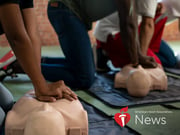By American Heart Association News

THURSDAY, June 1, 2023 (American Heart Association News) -- At a CPR class in Spanish in central Virginia, some members of the Latino community say they recognize that the technique can save someone whose heart stops beating. But they acknowledge that fear and uncertainty might keep them from providing critical care.
Such apprehension has prompted trainers who have witnessed it to teach not just how to administer CPR properly to a person who goes into cardiac arrest, but also to share culturally appropriate information that can ease concerns.
"We address the hesitation, we address the fears," said Dr. Max Luna, a cardiologist and director of the Latino Health Initiative at the University of Virginia in Charlottesville. The CPR class is one of the initiative's programs. "We focus on getting people comfortable with CPR."
Cardiac arrest happens when a person's heart suddenly stops. The person loses consciousness and the heart stops pumping blood out to the brain, lungs and other organs. CPR mimics how the heart pumps, using chest compressions to keep blood flowing throughout the body.
More than 350,000 cardiac arrests occur outside hospitals each year in the United States, according to American Heart Association statistics. Cardiac arrests most often happen at home.
Research has found that Hispanic and Black people, including children, who experience cardiac arrest in a public setting – such as a workplace, transportation center or recreational facility – are less likely than their white peers to receive CPR from a lay responder.
At the Latino Health Initiative , the goal is to increase the number of Latino people who are prepared to give CPR in an emergency, said Luna, who also is an associate professor of cardiovascular medicine at the university's medical school.
"That is a gap that we would like to narrow."
Luna said the initiative's CPR classes include information about AEDs, short for automated external defibrillators, but no formal instruction on the easy-to-use devices that can restore a normal heart rhythm. Once the AED is turned on, voice prompts guide the user through the process, but only some devices offer instruction in Spanish.
Luna said he and his colleagues have found that many residents in Hispanic neighborhoods don't know how to administer CPR. Language is another barrier, as not all 911 call centers have dispatchers who speak Spanish. Other reasons include immigration status and mistrust of police.
"Some people don't speak (English), and they are really in fear of calling 911 because they are probably not going to be able to convey a message, or they may be in a situation where the family is of mixed immigration status and the presence of law enforcement in the setting of cardiac arrest is not ideal," Luna said.
Other Latinos worry about landing in legal trouble if they're sued for inadvertently hurting a person in cardiac arrest, he said. For example, high-quality CPR often results in broken ribs. So, the CPR trainers review "Good Samaritan" laws that are aimed at protecting those who volunteer to aid an injured or sick person in an emergency.
Luna said that providing CPR training in Spanish not only demystifies the process, it also serves to raise awareness and reduce uneasiness.
In 2008, the AHA said hands-only CPR – which is chest compressions alone – can be just as effective in the first few minutes after a cardiac arrest as compressions and rescue breaths. Hands-only CPR is the technique Luna and his colleagues teach.
Maggie del Valle, a CPR trainer in Los Angeles for two decades, said she believes using both compressions and breaths – two rescue breaths after every 30 compressions – can yield optimal results. But she understands that performing chest compressions only is an effective and good option for anyone who may be "worried about disease transmission or isn't comfortable giving breaths" to another person.
While del Valle's company offers CPR classes in Spanish, most of those who attend are medical professionals, such as EMTs. "It's a very small portion" who take it for their own personal benefit, she said.
Formal CPR training with certification isn't needed to perform the lifesaving procedure, according to AHA guidance. To perform hands-only CPR on a teen or adult, place the heel of one hand in the center of the chest. Place the other hand on top and interlock the fingers. Push hard and fast at a pace of 100 to 120 times per minute. Online videos also are available, including in Spanish.
The response to the CPR training at the Latino Health Initiative has been positive, Luna said, and plans are being made for a similar initiative in Black communities. "It has to be tailored to every culture because each one has a different set of needs, fears and concerns."
American Heart Association News covers heart and brain health. Not all views expressed in this story reflect the official position of the American Heart Association. Copyright is owned or held by the American Heart Association, Inc., and all rights are reserved.
By Lourdes Medrano, American Heart Association News
Back

The news stories provided in Health News and our Health-E News Newsletter are a service of the nationally syndicated HealthDay® news and information company. Stories refer to national trends and breaking health news, and are not necessarily indicative of or always supported by our facility and providers. This information is provided for informational and educational purposes only, and is not intended to be a substitute for medical advice, diagnosis, or treatment.






